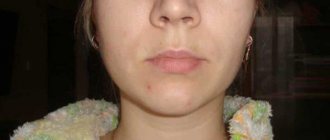Read in the article:
- Why does my throat hurt after drinking alcohol?
- How to relieve a sore throat
- Myths about treating throat problems with alcohol
- Swelling of the uvula
- Treatment of alcoholism
The article was prepared by expert
Chekmarev Maxim Sergeevich
Psychotherapist, psychiatrist, psychiatrist-narcologist
When a sore throat occurs, a person often resorts to treatment with folk or improvised remedies. Many people even decide to “treat” themselves with vodka, without even realizing that it is alcohol that can cause pain. Once in the mouth, vodka can burn the mucous membrane and even damage the vocal cords. In this article we will tell you the reasons why a sore throat may hurt after drinking alcohol, how to cure it and avoid recurrence of the disease.
Why does my throat hurt after drinking alcohol?
In order to make a decision about treatment, it is necessary to know why a person experiences a sore throat after drinking alcohol. There may be several reasons for this:
- Ethyl alcohol acts aggressively when it enters the oral cavity. Very often it causes swelling of the throat and uvula. If you experience such symptoms, you should immediately call an ambulance, as swelling of the throat and uvula can be fatal.
- Microcracks in the tongue and mouth can become inflamed upon contact with alcohol.
- An overdose of alcohol causes vomiting containing gastric juice and hydrochloric acid. It also burns the oral mucosa.
Description and causes of injury
A laryngeal burn is damage to the mucous membranes that occurs as a result of exposure to high temperatures or aggressive chemicals. This injury is quite widespread in everyday life, because a burn to the pharynx can be caused by consuming hot food and drinks. Damage from alcohol or acetic acid, Lugol, iodine, caustic alkalis, and concentrated steam is often found.
Experts consider a chemical burn to the throat to be the most difficult in terms of treatment and further recovery. Even a visit to the dentist can provoke injury, for example, if arsenic or other potent drugs come into contact with the mucous membranes of the larynx.
Young children are also susceptible to this type of damage and, due to their curiosity, may well try household chemicals. According to the international classification, burn injuries to the throat are divided by specialists into 3 degrees:
- Burn of the nasal mucosa: causes, symptoms, treatment methods
- The first degree is characterized by redness of the larynx and swelling of the mucous membranes.
- The second degree - manifests itself with specific blisters and the formation of gray films on a red and swollen throat.
- Third degree - manifested by necrosis of the affected tissues. Muscle tissue, ligaments and cartilage tissue are affected.
Lesions of the larynx of the second and third degrees require competent and timely assistance to the victim. Otherwise, extremely serious consequences are possible in the form of an attack of suffocation, poisoning, scarring and even the death of the patient!
How to relieve a sore throat
If your throat becomes sore after drinking alcohol, it is important to quickly respond to the symptoms and prevent further development of the disease. First of all, you need to call an ambulance. Until the doctors arrive, you need to provide first aid to the person:
- Stop drinking alcohol.
- Give an antihistamine for swelling.
- Take plenty of liquid and lie down.
- In case of a burn to the mucous membrane, it is necessary to gargle with chamomile infusion, a spoonful of soda or a pinch of salt, and a calendula solution.
- Try to avoid physical or psycho-emotional stress.
Emergency measures
In such a situation, it is very important to take emergency care in time, this will help avoid complications:
- In case of a chemical burn to the throat, it is necessary to stop all contact with the aggressive substance.
- If a Lugol burn occurs on your throat, you should drink cold milk in small sips. This will cool the affected area and flush out the stomach at the same time.
- In order to relieve pain, you can use a solution of Novocaine or Lidocaine.
- To reduce swelling during a Lugol burn, take any antihistamine: Loratadine, Fenistil, Diazolin.
It is important to alleviate the condition of the victim; to do this, you need to provide a flow of fresh air and go outside. The patient must be silent, the muscle tissues and ligaments need rest!
Swelling of the uvula
Drinking alcohol can lead to such a dangerous pathology as swelling of the uvula. If timely measures are not taken, a person may simply die.
Inflammation of this part of the mouth is called uvulitis. The first signs of pathology development:
- redness of the tongue;
- pain when swallowing;
- gagging;
- labored breathing;
- temperature increase;
- speech problem;
- feeling of a lump in the throat;
- painful dry cough.
If timely measures are not taken, the swelling will continue to the stage of blocking the nasopharyngeal lumens. This situation leads to asphyxia (suffocation) with a fatal outcome.
In this situation, it is important to first stop the development of the inflammatory process. To do this, give the patient an allergy medicine and call an ambulance.
Symptoms of alcohol poisoning
Experts divide body intoxication into three categories:
– mild alcohol poisoning;
– average degree;
– severe intoxication.
If a person has experienced a mild degree of poisoning from alcohol-containing drinks, then he may experience the following symptoms:
– hyperpigmentation of the skin;
– increased excitability, and sometimes aggressiveness;
– being in a euphoric state;
– the appearance of hypertrophied character traits (increased level of conflict, stinginess, generosity, etc.);
– a significant decrease in self-control and the appearance of inflated self-esteem;
– loss of coordination of movements.
If you stop drinking alcoholic beverages at this stage, you may only experience a hangover. In cases where drinking continues, a moderate degree of poisoning may occur, which is accompanied by the following symptoms:
– slowdown of intellectual processes;
– unintelligible speech;
– violation of orientation in space and time;
– the occurrence of dyspeptic disorders (nausea, pain in the stomach area, diarrhea, vomiting);
- appearance of drowsiness.
Having stopped consuming products harmful to the body at this stage, the drinker falls into deep sleep. In some cases, immediate first aid may be required, which will allow the person’s condition to normalize after 12 hours.
Severe alcohol poisoning is accompanied by more pronounced symptoms:
- Being in an unconscious state.
- Lack of response to painful and tactile stimuli.
- Disturbances in the functioning of the cardiac, vascular, and respiratory systems (rare pulse, shortness of breath, drop in blood pressure, etc.).
- Decreased body temperature.
In such situations, it is impossible to do without qualified medical care, since severe poisoning can cause alcoholic coma. In the absence of proper procedures, which are carried out exclusively by professionals, everything will end in death.
Poisoning can occur not only due to the use of ethyl, but also other alcohols that are used in the creation of surrogates. As a rule, in such cases, wood or methyl alcohol is used. Poisoning with these substances is extremely dangerous and leads to human death. When they are consumed, pathological intoxication is observed, the level of which differs significantly from the dose consumed. The main manifestations of methanol intoxication are similar to those mentioned above, but the difference is that after 2-4 days after consuming the drinks, vision problems appear, leading to irreversible consequences (blindness, blurring, double vision).
Symptoms of a throat burn
Symptoms of burns are the same when the mucous membrane is exposed to both high temperatures and chemicals. The main symptoms of chemical and thermal burns of the throat mucosa are:
- Severe pain at the time of injury, which intensifies when swallowing;
- Intense burning , which in mild cases goes away after some time, but in severe cases it bothers you for quite a long time;
- Swallowing problems with more severe damage to the mucous membrane;
- The mucous membrane changes color . In case of a mild burn, it is hyperemic; in more severe cases, areas of white and gray color are noted. The photo shows what throat burns look like;
- Increased salivation;
- Voice change. He becomes hoarse. In some cases, the patient cannot speak;
- Inflammation of regional lymph nodes. They become painful on palpation, and their size increases;
- With severe burn wounds, breathing problems are observed in the form of severe shortness of breath and rapid heartbeat;
- A sharp disturbance in the general condition is associated with intoxication in severe burn injuries.
How to help the victim?
Successful treatment of a burn of the larynx is possible only with competent first aid.
First aid
| Iodine | Damage is caused by the use of concentrated iodine tincture for gargling or treating tonsils. | |
| Inorganic acids and alkalis | The following substances are especially dangerous:
The most common cause of upper respiratory tract injury is inhalation of vapors or accidental ingestion of a substance. | |
| Plants with irritant properties | Frequent cases are burns of the larynx from chili pepper or mustard when inhaling dry spices. The cause of chemical damage is the alkaloid capsaicin. | |
| Biological fluids | The cause of the damage is the regular reflux of acidic gastric contents into the respiratory tract and esophagus during gastroesophageal reflux and gastrotracheal fistulas. | |
| Organic acids (citric, acetic) | In case of ingestion of the solution. | With chemical lesions, the vestibular region (epiglottis, vestibular folds, arytenoid cartilages) is affected. At the site of contact of the substance with tissue, a local inflammatory reaction occurs, which is manifested by swelling and hyperemia of the damaged area. A characteristic feature of acid burns is coagulation (dry) necrosis. It is characterized by the formation of a dry crust. Damage is most often limited to the upper larynx. When exposed to alkali, wet necrosis forms. The mucous membrane becomes loose, which contributes to the spread of the chemical and damage to the lower respiratory tract. Another feature of chemical burns is the absorption of the chemical into the blood.
Thermal burnsA common cause is accidental ingestion of liquid that is too hot. It is also very dangerous to get hot steam into the respiratory tract.
The pathology is often combined with damage to the face, eyes and mouth. This worsens the patient's condition. |
Causes of the pathological process
Burns occur accidentally or intentionally. The main reasons for the development of this pathology are :
- Failure to comply with industrial safety regulations. In this case, ingestion of chemicals or inhalation of hot steam may occur;
- Consumption of strong alcoholic drinks, pure alcohol;
- Treatment of the throat mucosa with iodine and drugs based on it. Such drugs are used for sore throat and pharyngitis. But quite often a chemical burn occurs;
- Eating hot food. This is often observed in young children;
- Accidental use of chemicals. It is observed in young children who taste everything. This reason is also relevant for alcohol abusers, who may confuse the chemical with an alcoholic drink;
- Drinking excessively hot drinks (such as tea);
- Consumption of acids or alkalis for the purpose of suicide.
Read also: You can take a diuretic at night
Frequently asked questions to the doctor
ethnoscience
Good afternoon The daughter mistakenly took a sip of medical alcohol and mistook it for water. First there was vomiting. Then my daughter began to choke. I called an ambulance and she was taken to the hospital. They say she burned her neck. Please tell me how to quickly cure a burn of the larynx with alcohol? Maybe there are some traditional methods? They won’t let me leave the hospital, but we wanted to go to the seaside. Daughter is 10 years old.
Hello! Traditional medicine methods are ineffective in this case. I advise you to trust the doctors and complete the course of treatment.
Treatment
In case of a burn in the upper respiratory tract, after emergency care is provided, the victim is hospitalized in a hospital.
The extent of treatment depends on the cause of the burn and the severity of the injury.
Stages of therapy
| Call a medical team | Provide the operator with a detailed description of the situation. |
| Determine the cause of the burn | Interviewing witnesses to the incident and a careful examination can help with this.
|
| First aid | For a thermal burn:
In case of a chemical burn, it is recommended:
|
Prednisolone
After their condition improves, patients are transferred to the burn department. If it is necessary to continue intensive care, go to a specialized intensive care unit.
Nebulizer therapy for laryngeal burns
Positive results of inhalation therapy on the second day after injury:
- reducing swelling of the mucous membrane of the upper respiratory tract;
- elimination of respiratory failure;
- reduction of inflammation;
- restoration of swallowing;
- elimination of aphonia.
The recommended duration of the procedure is 10 minutes. Inhalations are carried out twice a day.
Aerosol mixture recipe:
- 50 ml 0.9% sodium chloride;
- "Trypsin" -10 mg;
- 2.5% hydrocortisone solution – 5 ml;
- 2.4% aminophylline solution – 1 ml;
- 4% sodium bicarbonate solution – 4 ml.
Also, good results are provided by inhalation of sympathomimetics (adrenaline), drugs that dilute sputum (acetylcysteine). The duration of the course is 7 days.
After reading the article, you will learn everything about how to treat a burn of the larynx and throat.
Main reasons
Burns of the laryngeal mucosa occur in both children and adults. Depending on the damaging factor, chemical and thermal burns are distinguished. The injury is rarely isolated and is usually combined with damage to the oral cavity, pharynx and esophagus.
Chemical damage to the mucosa
| Ethanol | A burn of the larynx with alcohol occurs: |
- with careless treatment of tonsils;
- ingestion of medical alcohol or tinctures (intentionally or by mistake).
Minor 1st and 2nd degree burns in adults do not pose a threat to life.











